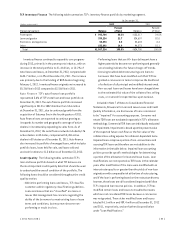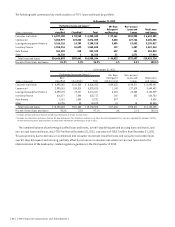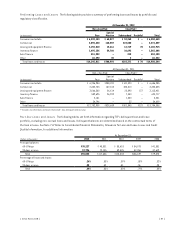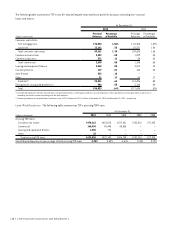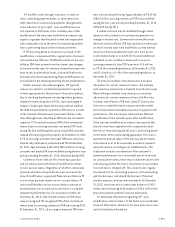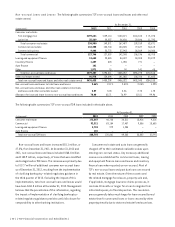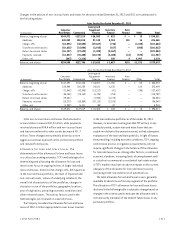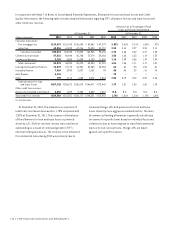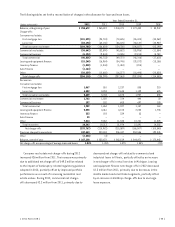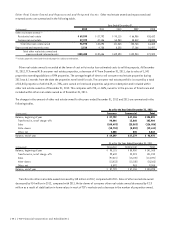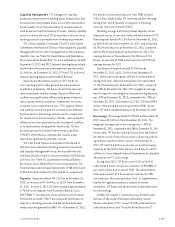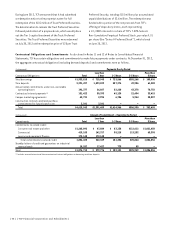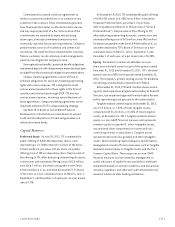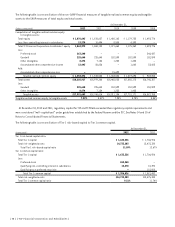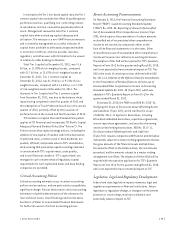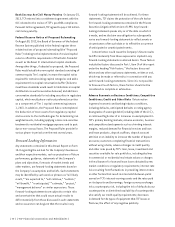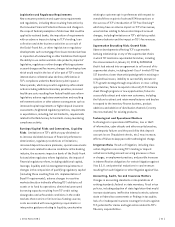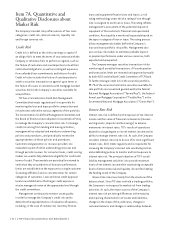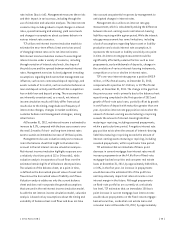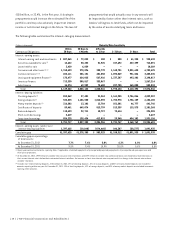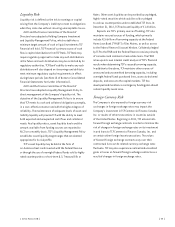TCF Bank 2012 Annual Report Download - page 61
Download and view the complete annual report
Please find page 61 of the 2012 TCF Bank annual report below. You can navigate through the pages in the report by either clicking on the pages listed below, or by using the keyword search tool below to find specific information within the annual report.Liquidity Management TCF manages its liquidity
position to ensure that the funding needs of depositors and
borrowers are met promptly and in a cost-effective manner.
Asset liquidity arises from the ability to convert assets to
cash as well as from the maturity of assets. Liability liquidity
results from the ability of TCF to maintain a diverse set of
funding sources to promptly meet funding requirements.
TCF’s Asset/Liability Committee (“ALCO”) and Finance
Committee of the Board of Directors have adopted a Liquidity
Management Policy to direct management of the Company’s
liquidity risk, see “Item 7A. Quantitative and Qualitative
Disclosures about Market Risk” for more information. At both
December 31, 2012 and 2011, interest-bearing deposits held
at the Federal Reserve and unencumbered securities were
$1.4 billion. At December 31, 2012, TCF had $712 million of
interest-bearing deposits at the Federal Reserve.
Deposits are the primary source of TCF’s funds for
use in lending and for other general business purposes.
In addition to deposits, TCF derives funds from loan and
lease repayments and borrowings. Deposit inflows and
outflows are significantly influenced by general interest
rates, money market conditions, competition for funds,
customer service and other factors. TCF’s deposit inflows
and outflows have been and will continue to be affected
by these factors. Borrowings may be used to compensate
for reductions in normal sources of funds, such as deposit
inflows at less than projected levels, net deposit outflows
or to fund balance sheet growth. Historically, TCF has
borrowed primarily from the Federal Home Loan Bank
(“FHLB”) of Des Moines, institutional sources under
repurchase agreements and other sources.
TCF’s ALCO and Finance Committee of the Board of
Directors have adopted a Holding Company Investment
and Liquidity Management Policy, which establishes the
minimum amount of cash or liquid investments TCF Financial
will hold, see “Item 7A. Quantitative and Qualitative
Disclosures about Market Risk” for more information. TCF
Financial had cash and liquid investments of $84 million and
$133 million at December 31, 2012 and 2011, respectively.
Deposits Deposits totaled $14.1 billion at December 31,
2012, an increase of $1.8 billion, or 15.2% from December
31, 2011. On June 1, 2012, TCF Bank assumed approximately
$778 million of deposits from Prudential Bank & Trust,
FSB (“PB&T”). The deposits consist primarily of Individual
Retirement Account (“IRA”) accounts with certificates of
deposit or checking accounts and IRA related brokerage
sweep accounts gathered by PB&T. As of December 31, 2012,
the balance of assumed deposits from PB&T totaled
$731 million. Additionally, TCF reintroduced free checking
during 2012, which resulted in net gains in checking
accounts in the second half of 2012.
Checking, savings and money market deposits are an
important source of low-cost funds and fee income for TCF.
These deposits totaled $11.8 billion at December 31, 2012,
up $622.9 million from December 31, 2011, and comprised
83.7% of total deposits at December 31, 2012, compared
with 91.3% of total deposits at December 31, 2011. The
average balance of these deposits for 2012 was $11.4
billion, an increase of $582 million over the $10.9 billion
average balance for 2011.
Certificates of deposit totaled $2.3 billion at
December 31, 2012, up $1.2 billion from December 31,
2011, due to special programs offered in select markets
during 2012. Non-interest bearing deposits represented
17.7% of total deposits at December 31, 2012, compared
with 20% at December 31, 2011. TCF’s weighted-average
rate for deposits, including non-interest bearing deposits,
was .33% at December 31, 2012, compared with .29% at
December 31, 2011. At December 31, 2012, TCF had $294.3
million of brokered deposits acquired from PB&T in June
2012. TCF had no brokered deposits at December 31, 2011.
Borrowings Borrowings totaled $1.9 billion at December 31,
2012, down $2.5 billion from December 31, 2011. The
weighted-average rate on borrowings was 1.42% at
December 31, 2012, compared with 4.26% at December 31, 2011.
Historically, TCF has borrowed primarily from the FHLB of
Des Moines, from institutional sources under repurchase
agreements and from other sources. At December 31,
2012, TCF had $2.6 billion in unused, secured borrowing
capacity at the FHLB of Des Moines. See Notes 11 and 12
of Notes to Consolidated Financial Statements for detailed
information on TCF’s borrowings.
During June 2012, TCF Bank issued $110 million of
subordinated notes, at a price to investors of 99.086% of
par, which will be due on June 8, 2022. The subordinated
notes bear interest at a fixed rate per annum of 6.25%
until maturity. The notes qualify as Tier 2, or supplementary
capital for regulatory purposes, subject to certain
limitations. TCF Bank used the proceeds to pay down short
term borrowings.
In 2008, TCF Capital I, a statutory trust formed under
the laws of the state of Delaware and wholly-owned
finance subsidiary of TCF, issued 10.75% preferred junior
subordinated notes (the “Trust Preferred Securities”).
{ 2012 Form 10K } { 45 }


